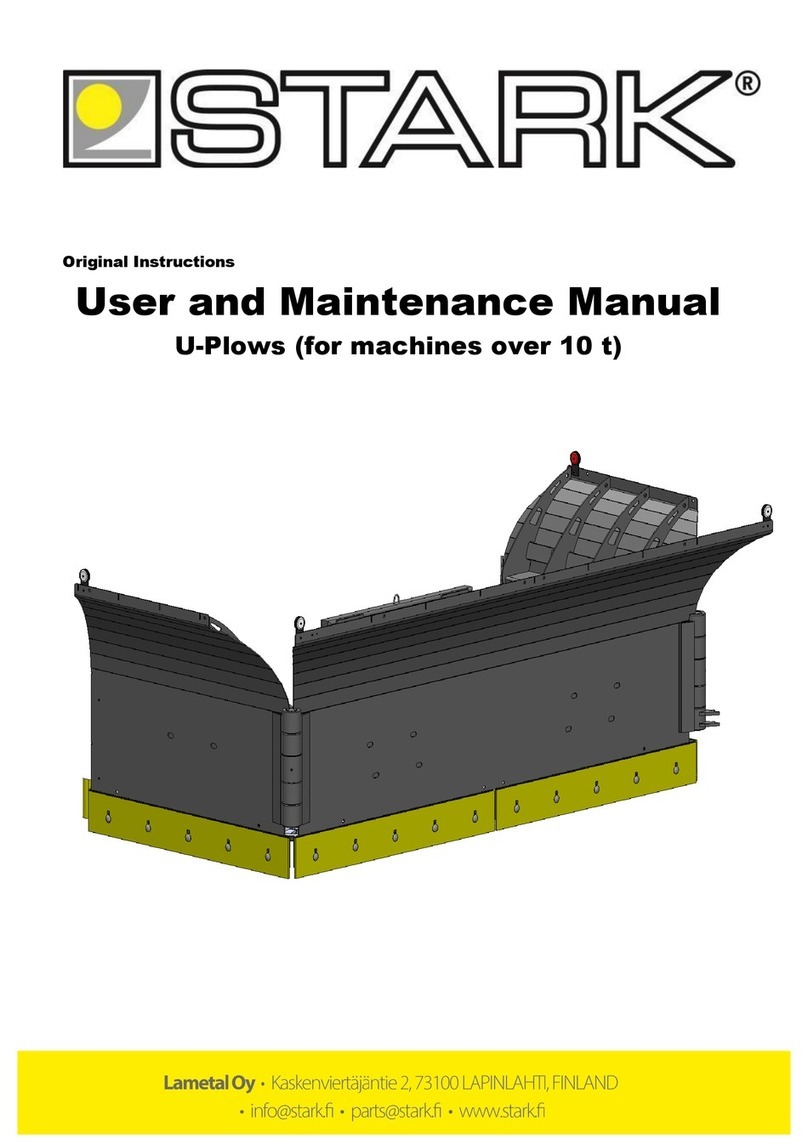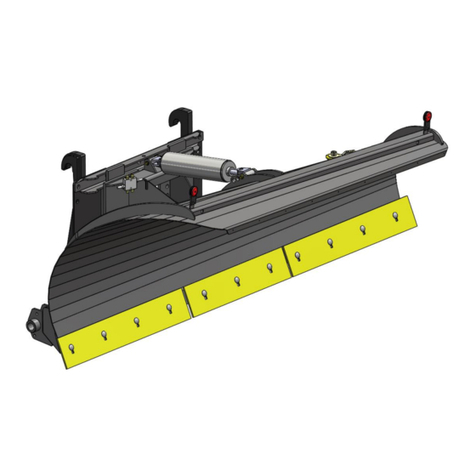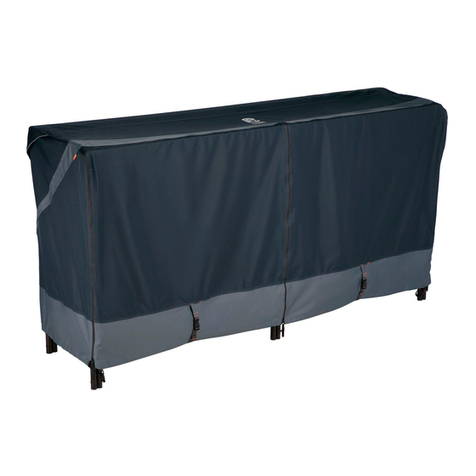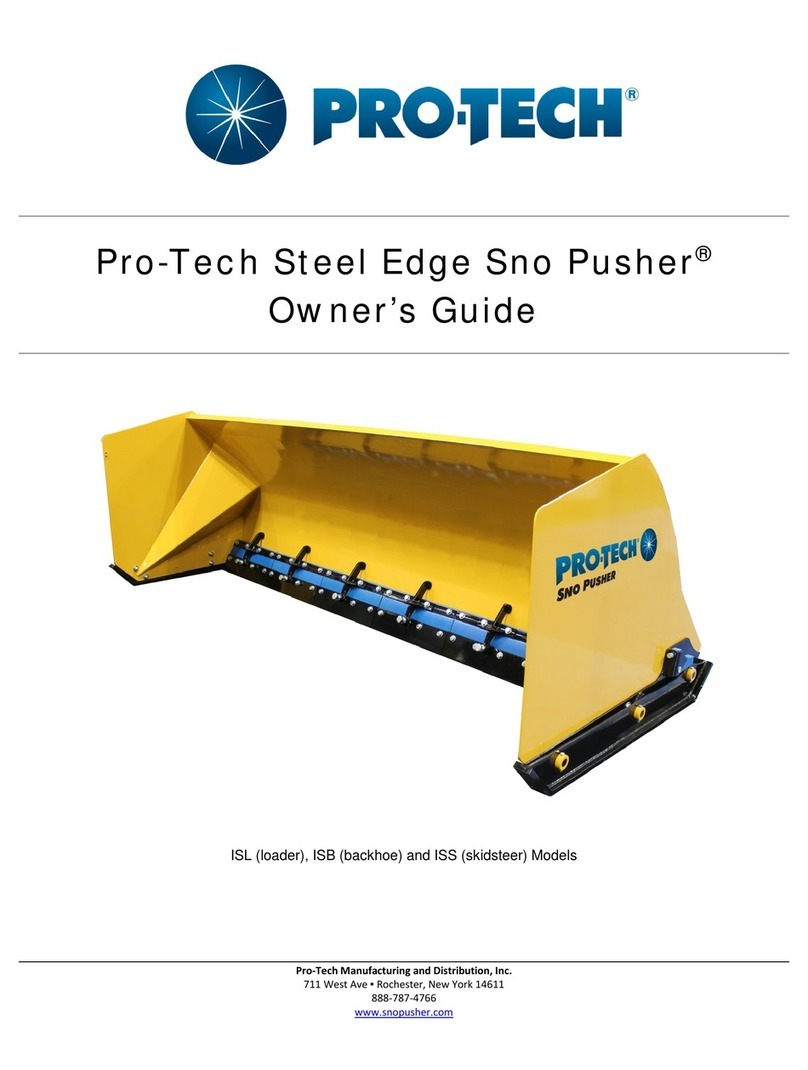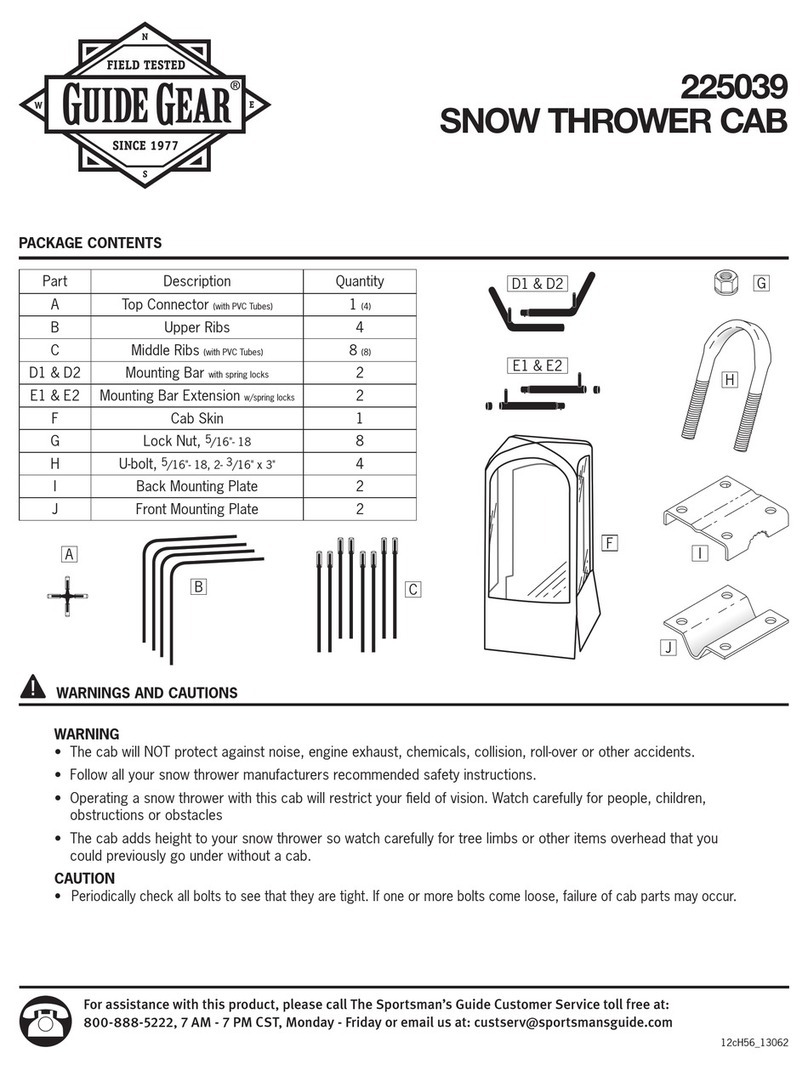Stark U-AURA Series Operating instructions

Original
Operating and maintenance
manual
Bucket spreader

Sivu 2 / 17
General
Congratulations on the purchase of your STARK Bucket spreader!
For us, the long lifecycle and efficiency of your new equipment is a priority. To keep the bucket spreader in top working
condition, read this manual carefully before using the equipment.
STARK products are engineered and manufactured in Finland, and each of them is equipped according to the needs of
the customer.
Never let anyone operate or maintain the device without reading this manual carefully! Always make sure that safety
precautions are observed in use and maintenance. Keep this manual for future reference and make sure to hand it over
to a new owner.
The cornerstones of the product development of STARK attachments are quality, durability and economy. The products
are engineered to be high-performing, safe and durable in professional use. Any feedback on our products is welcome
and contributes to the further development of our products. If you have any questions about the use or maintenance of
the bucket spreader, please contact us by e-mail: [email protected]
Visit our webpage www.stark.fi for the complete product range, including new products.
The manufacturer reserves the right for structural and technical changes without prior notice. Therefore, some pieces of
information given in the manual may have changed after printing this manual.
Read before use
Make sure you know your equipment before you start using it.
Equipment may be operated only by an individual who is thoroughly familiar with its use.
All operators must be properly instructed before use and maintenance of the equipment. Use by
individuals with insufficient instructions may pose serious risks to the operators themselves, to the
environment and the equipment.
When coupling the attachment to the base machine, make sure:
-that all locking cotters are intact and in order
-there is no pressure in the hydraulic system
-that hydraulic hoses are intact
-there is no skin contact to hydraulic oil when connecting hydraulic hoses
-not to pull by the hydraulic hoses, but only by the hydraulic fitting
During operation, pay attention to:
-safe, appropriate travel speed
-other traffic, people and animals
-danger zones and objects that block your view
-children
NEVER use the machine if there is someone in the danger zone.
NEVER go under the attachment.

Sivu 3 / 17
Table of contents
General.................................................................................................................................................2
Read before use ...................................................................................................................................2
1. DECLARATION OF CONFORMITY......................................................................................................4
2. PURPOSE OF USE..............................................................................................................................5
3. SAFETY PRECAUTIONS......................................................................................................................5
4. IDENTIFICATION INFORMATION AND SPAREPARTS ........................................................................6
4.1. Identification plate ............................................................................................................................ 6
4.2. Maintenance services........................................................................................................................ 6
5. MAIN PARTS OF THE BUCKET SPREADER.........................................................................................7
6. ATTACHING THE BUCKET SPREADER................................................................................................8
6.1. Attaching the bucket spreader to a base machine............................................................................ 8
7. OPERATING THE BUCKET SPREADER................................................................................................9
7.1. Operating instructions....................................................................................................................... 9
7.2. Adjusting the sanding roller rubber................................................................................................. 10
7.3. Adjusting the chain.......................................................................................................................... 11
7.4. Detaching the bucket spreader ....................................................................................................... 12
7.5. Transferring the bucket spreader.................................................................................................... 12
7.6. Bucket spreader accessories ........................................................................................................... 12
8. MAINTAINING THE BUCKET SPREADER .........................................................................................13
8.1. General safety precautions for use and maintenance .................................................................... 13
8.2. Tightening torque............................................................................................................................ 13
8.3. Daily maintenance........................................................................................................................... 13
8.4. Maintenance after 10 hours............................................................................................................ 13
8.5. Maintenance after every 50 workhours or weekly ......................................................................... 13
8.6. Lubrication points............................................................................................................................ 14
9. HYDRAULICS...................................................................................................................................15
10. WARRANTY POLICY ......................................................................................................................17

Sivu 4 / 17
1. DECLARATION OF CONFORMITY
The original manufacturer’s EC declaration of conformity:
Generic product name: Bucket spreader
Models: HK 310, HK 360, HK 400, HK460, HK 560, HK 710, HK 1010, HK 1400, HK 1800, HK 2200, HK 2600, HK 3010
Manufacturer:
Lametal Oy
Kaskenviertäjäntie 2 73100 LAPINLAHTI, Finland
tel. +358 17 731 565
Declares that the above-mentioned equipment meets the provisions of Directive 2006/42/EC on machinery and, where
applicable, complies with the standards
•SFS-EN ISO 12100-1,
•SFS-EN ISO 12100-2
•SFS-EN 1050
The person authorized to compile technical documentation:
Lassi Mehtonen
Managing director
Kaskenviertäjäntie 2
73100 Lapinlahti, FINLAND

Sivu 5 / 17
2. PURPOSE OF USE
The Bucket spreader is used for sanding streets and small / large areas.
3. SAFETY PRECAUTIONS
Make sure you know your equipment before you start using it. Equipment may be operated only
by an individual who is thoroughly familiar with its use.
Before connecting hydraulics to the base machine, make sure that:
-there is no-one between the attachment and the base machine
-the base machine is turned off and the parking brake is on.
When coupling the attachment to the base machine, make sure that:
-all locking cotters are intact and in order
-hydraulic hoses are intact
-there is no skin contact to hydraulic oil when connecting hydraulic hoses
-you do not to pull by the hydraulic hoses, but only by the hydraulic fitting.
During operation, pay attention to:
-safe, appropriate travel speed
-other traffic, people and animals
-danger zones and objects that block your view
-children
-use of turn signal when driving
NEVER use the machine, if there is someone in the danger zone
NEVER go under the attachment
WARNING! Rotating rollers!
During maintenance, the hydraulics of the base machine MUST be turned off. The base machine MUST also be turned
off and the parking brake MUST be applied. The equipment must be properly supported, if maintenance can only be
performed by going under the equipment. Never go under the equipment if it is not properly supported.
Daily maintenance:
-check general condition of structures, make repairs if needed
-check the hydraulic hoses and fittings, and replace damaged parts
After every 50 hours of operation:
-lubricate points specified in the product specific section of this manual
-check all bolts and nuts for tightness
Check all bolts, nuts and hydraulic fittings for tightness after the first day of operation!
If the equipment is not likely to be used for a longer period, clean it thoroughly after use and lubricate as instructed.
WARNING! Pressurized hydraulic hoses and components!

Sivu 6 / 17
4. IDENTIFICATION INFORMATION AND
SPAREPARTS
4.1. Identification plate
Identification plate is placed on the side of the equipment. The plate includes contact information, machine type, year of
manufacture, serial number and weight. (See an example of an identification plate in picture 1 below).
The first four numbers in the serial number indicate the month and year of manufacture (month first). The remaining five
numbers constitute the machine tracking number, which is stored in the manufacturer’s database (13971 in the example
below).
Picture 1. Identification plate
Take down the machine type and the serial number of your bucket spreader:
Product and model _______________________________Serial number___________________________________
4.2. Maintenance services
When replacing parts, use original, manufacturer spare parts only. By using original spare parts, you ensure dependable
operation of the bucket spreader and comply with the warranty policy. To facilitate the supply of spare parts, always
inform the manufacturer/retailer of the model and serial number of the bucket spreader (marked in the identification
plate) when you order spare parts.
For more information on maintenance and spare parts, please contact the STARK maintenance and spare part services
or your retailer.
Contact information for STARK maintenance services:
tel. +358 (0)17 731 565, e-mail info@stark.fi
tel. +358 (0)44 758 6221, e-mail parts@stark.fi

Sivu 7 / 17
5. MAIN PARTS OF THE BUCKET SPREADER
Picture 2. Main parts of the bucket spreader
1) Frame of the bucket spreader
2) Spreader roll
3) Mixing shaft
4) Engine’s case
5) Hydraulic engine
6) Flow control valve

Sivu 8 / 17
6. ATTACHING THE BUCKET SPREADER
When attaching the bucket spreader for the first time, make sure it is compatible with the base machine by following the
instructions below. Always check the compatibility when attaching the bucket spreader to a new base machine.
6.1. Attaching the bucket spreader to a base machine
The bucket spreader is attached to the base machine by welded or bolted STARK FIT quick hitches. The machine is
connected to a hydraulic system. Hydraulic circuit diagrams can be found in a later section in this manual. Ask your
retailer for available STARK FIT quick hitches.
Before using the bucket spreader, MAKE SURE all locking cotters and pins are secured and intact.
When coupling the bucket spreader to the base machine, please pay attention to the instructions on the use of the base
machine.
1. Make sure that the attachment and the base machine are compatible in terms of mechanical solutions, hydraulics and
electricity.
2. The bucket spreader is attached to the coupler on the base machine (e.g. a loader). Attach the bucket spreader to the
base machine, and make sure the locking cotters and pins are secured. Apply parking brake.
3. Turn off the base machine and make sure the parking brake is applied.
4. Make sure there is no pressure in the base machine hydraulic system. When connecting, always make sure the
hydraulic connectors are clean and the hoses are intact
5. Check carefully the attachment’s, the base machine’s and the fitting’s trajectory for collision. Do a test run using the
base machine and the loader in extreme position to check that the bucket won’t collide with base machine. Make sure
that the hydraulic hoses and attachments have enough space. If needed change the location of hoses in the base
machine.
6. During first hours of operating the attachment, bolts, nuts and connectors might loosen up. Retighten them after the
first day of operating the attachment.

Sivu 9 / 17
7. OPERATING THE BUCKET SPREADER
Before using the bucket spreader, make sure:
-the bucket spreader is installed correctly
-all locking pins are in place
-hydraulic hoses are connected properly
-hoses are intact
-there are no oil leaks
-all functions are working properly
7.1. Operating instructions
1. Make sure that the attachment and the base machine are compatible in terms of mechanical solutions,
hydraulics and electricity
2. The bucket spreader is attached to the coupler on the base machine (e.g. a loader). Attach the bucket spreader
to the base machine, and make sure the locking cotters and pins are secured.
3. Turn off the base machine and make sure the parking brake is applied.
4. Make sure there is no pressure in the base machine hydraulic system. When connecting, always make sure the
hydraulic connectors are clean and the hoses are intact.
5. Check the attachment’s, the base machine’s and the fitting’s trajectory for collision. Make sure that the hydraulic
hoses and attachments have enough space.
6. Push the bucket spreader to the sandpile slowly and turn the bucket up with the loader. Work with careful,
steady movements in order to avoid damage to the bucket or the base machine.
7. When using a 3-point filling cylinder, slow down the cylinder movement in order to avoid damage to the bucket
or the base machine.
8. Adjust the flow of sand by a flow control valve, engine’s rotational speed and driving speed so it is appropriate
in the working area.
9. Stay alert for any abnormal behavior and oil leaks also during driving.

Sivu 10 / 17
7.2. Adjusting the sanding roller rubber
The sanding roller rubber is a wear part. Make sure to check its condition and tightness before the winter season.
Adjusting of the sanding roller rubber:
-loosen the fixing bolts of the protective plates,
-push the rubber out of the opening (e.g. with a screwdriver) firmly against the discharge shaft (Picture 3).
-Tighten the bolts of protective plates to the correct torque. The worn rubber can be turned around.
Picture 3. Adjusting the sanding roller rubber

Sivu 11 / 17
7.3. Adjusting the chain
The spreader roll and the mixing shaft are operated by a hydraulic engine chain. The chain needs to be checked for
tightness every 50 hours of operation to make sure that the bucket spreader works properly. Remove the protective cap
and press the chain e.g. with a screwdriver with a force of 25 kg. If the chain gives in more than 5-10mm, it needs to be
tightened (Picture 4).
Tightening the chain:
-Loosen the tightening nuts
-Adjust the chain with a chain tightener
-Tighten the nuts to the right torque (table 1)
NOTE! The chain can be adjusted without opening engine’s case. However, if you must open the protective lid of the
engine case, seal it off with adhesive paste when closing. This way dust or dirt does not damage the chain.
Picture 4. Adjusting the chain
Protective cap
Chain tightener
Tightening nuts

Sivu 12 / 17
7.4. Detaching the bucket spreader
1. Lower the bucket spreader to an even ground.
2. Turn off the base machine, put on the parking brake and release pressure from the system
3. Detach the hydraulic hoses and protect the couplings with plugs
4. Open the mechanical lock and loosen the bucket spreader
5. If the bucket spreader is left unused for a long period of time, it needs to be clean and lubricated properly before
storage.
7.5. Transferring the bucket spreader
Lift the bucket spreader high enough and reduce speed if needed, especially on bumby, uneven roads. The bucket
spreader or the base machine can be damaged due to excessive speed.
7.6. Bucket spreader accessories
The following accessories are available for the bucket spreader:
-Filling cylinder with a lock valve
-Hot-dip galvanisation
-Remote controlled flow control valve
-Vibration device

Sivu 13 / 17
8. MAINTAINING THE BUCKET SPREADER
8.1. General safety precautions for use and maintenance
-Comply with the applicable laws and regulations and the instructions in this manual.
-Never go under the bucket spreader if it is not supported.
-Always put on the base machine’s parking brake before any servicing on the attachment.
-Use only tools which are in good condition.
-Watch out for pressurised hydraulic hoses and components.
-Make sure there is no pressure in the hydraulic system. Take into account the pressure accumulator.
-Do not let hydraulic fluids or lubricants to the ground.
-Wear appropriate personal protective equipment.
8.2. Tightening torque
Nm (Strength 8.8)
M4
3,3
M5
6,5
M6
11,3
M8
27,3
M10
54
M12
93
M14
148
M16
230
M18
329
M20
464
M22
634
M24
798
M27
1176
M30
1597
M33
2161
M36
2778
M39
3597
Table 1. Tightening torque
8.3. Daily maintenance
It is important to perform a daily visual inspection of the attachment for early detection of possible faults and to prevent
further damage. Inspect the following items on the bucket spreader daily:
-Hydraulic hoses and components for possible leaks
-General mechanical condition
8.4. Maintenance after 10 hours
-Lubricate, recommended quality NLGI-2 grade grease or equivalent (shown in the later section)
-Check the bolts for tightness (table 1.)
8.5. Maintenance after every 50 workhours or weekly
-Lubricate, recommended quality NLGI-2 grade grease or equivalent (shown in the later section)
-Check the mechanical condition of the bucket spreader for distortion or breach
-Check the fastening bolts for tightness
-Check the chain for tightness (shown in the earlier section)

Sivu 14 / 17
Picture 6. Grease nipples of the bearings and of the chain
8.6. Lubrication points
1) Grease nipples of the bearings
2) Grease nipples of the bearings and of the chain
1
2
Picture 5. Grease nipples of the bearings

Sivu 15 / 17
9. HYDRAULICS
The bucket spreader is attached to the base machine with 2-hose hydraulics (chart 1). The system has been tested and
adjusted by the manufacturer. Any alterations or modifications to the hydraulic system are on the sole responsibility of
the client.
Max. pressure: 120 bar
Max. oil flow: 120 l/min.
Max. counter pressure for returning oil 75 bar
The Bucket Spreader has a double pressure relief valve, with a pressure setting of 120 bar. Higher pressure adjustment
is strictly prohibited. Max. allowed oil flow is 120l / min. A larger flow controller is required for higher oil flow from
the base machine. Please contact STARK spare parts sales!
Due to counter pressure in the return line, some oil may leak in the Bucket spreader motor housing (this may damage
the engine sealing). Open and drain the leaking oil out of the housing every 80 hours (Picture 7).
The maximum counter pressure of the returning oil from the Bucket Spreader is 75 bar, depending on speed (chart 2).
Chart 1. Hydraulic chart for the bucket spreader

Sivu 16 / 17
Picture 3. Drain line greasing nipple at the end of the motor housing
Chart 2. The counter pressure of the returning oil

Sivu 17 / 17
10. WARRANTY POLICY
1. Warranty coverage
Lametal Oy, the manufacturer of STARK attachments, offers new devices a guarantee which covers material
and manufacturing defects in accordance with the terms in this warranty policy. Limitations to the warranty are
specified in point 7.
2. Warranty starting date
The warranty starts on the agreed date of product delivery to the client, or on the date of approved instalment or
on the date the equipment has been taken into operation. The equipment is taken into operation when it has
been delivered to the client in accordance with the agreement and the client has acknowledged receipt of the
equipment. The client is to check the equipment before use as instructed in this manual and to notify the
manufacturer or the reseller of the equipment of any defects or flaws that are noticed during initial inspection.
This notification is to be done in writing within eight (8) days after delivery. Hidden defects and defects that are
otherwise difficult to detect must be reported immediately after detecting them, within one (1) year after receipt
of the equipment at the latest.
3. Warranty period
STARK warranty covers a period of one (1) year. If need be, the client and the manufacturer make separate
agreements on warranty concerning repairs and spare parts used in repairs.
4. Repairs during the warranty period
Repairs during the warranty period are carried out free of charge within the normal working hours by the
manufacturer repair and maintenance services or by a repair service provider accredited by the manufacturer. If
repairs are carried out by a repair service provider which has not been accredited by the manufacturer, the
manufacturer does not compensate for costs that are not covered by the warranty, such as travel and waiting
hours, daily allowances, travel expenses or costs arising from detaching and reinstalling the equipment. The
manufacturer does not compensate for indirect costs caused by repairs during the warranty period, such as lost
working hours. Original parts replaced during the warranty period shall remain with the manufacturer. The client
must keep the damaged parts for six (6) months unless otherwise agreed, and have them delivered to the
manufacturer without delay upon request.
5. Conditions for repair under warranty
Manufacturer’s instructions for operation, instalment and maintenance have been followed.
The equipment was damaged when operated in conditions for which it has been engineered.
In maintenance and repairs, only original, manufacturer parts have been used.
The form for the notification of defects provided by the manufacturer or the retailer has been filled in according
to the instructions and submitted for processing.
6. Warranty after repair
Warranty holds until the end of the original warranty period. Repair under warranty does not prolong the
warranty period.
7. Limitation to the warranty
The warranty does not cover:
oconsequential expenses resulting from the damaged equipment
oindirect costs, such as loss of working hours
odamages caused to a third party
oequipment or components that have been modified or repaired by the client themselves
odamages caused by normal wear and tear, inappropriate maintenance operations, neglect, accident,
connecting error, equipment overloading, user’s inexperience or use of other than original parts
The warranty offered by the manufacturer does not exceed the purchase price of the equipment.
8. Warranty claim procedure
For a warranty claim to be processed, the form for the notification of defects provided by the manufacturer or
the retailer must be filled in according to the instructions and submitted for processor. The warranty claim
procedure is carried out either in Finnish or English.
This manual suits for next models
1
Table of contents
Other Stark Snow Blower Accessories manuals
